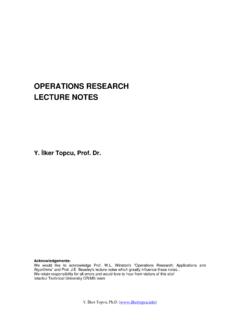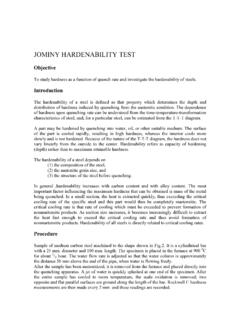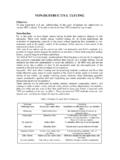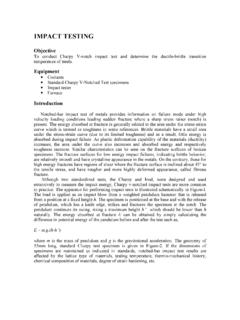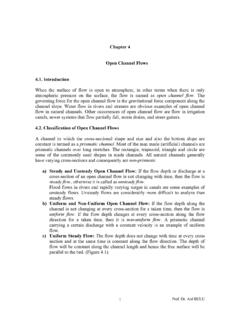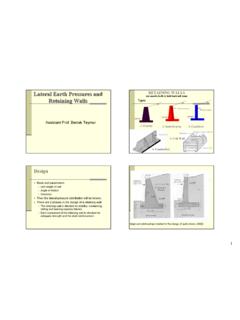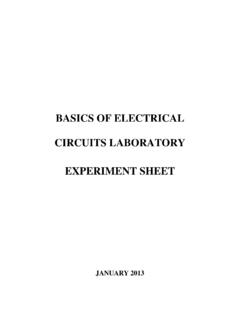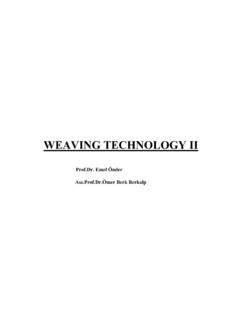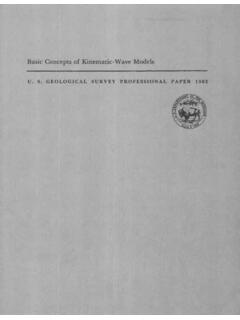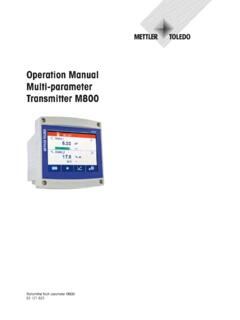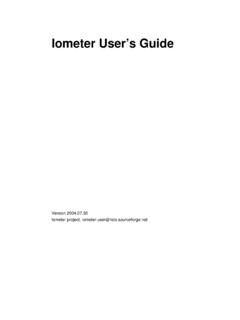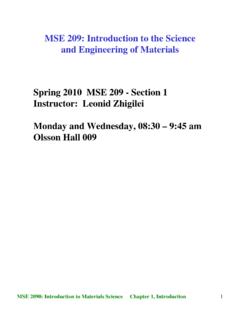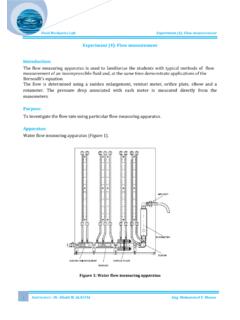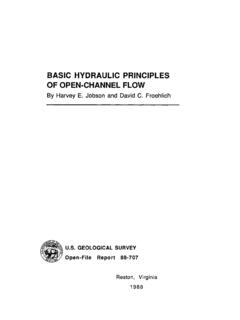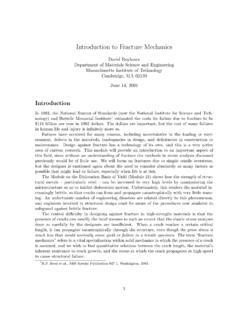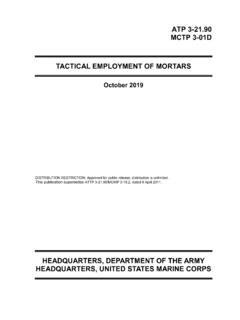Transcription of LECTURE NOTES - I
1 LECTURE NOTES - I FLUID MECHANICS Prof. Dr. At l BULU Istanbul Technical University College of Civil Engineering Civil Engineering Department Hydraulics Division CHAPTER 1 FUNDAMENTALS introduction Man s desire for knowledge of fluid phenomena began with his problems of water supply, irrigation, navigation, and waterpower. Matter exists in two states; the solid and the fluid, the fluid state being commonly divided into the liquid and gaseous states. Solids differ from liquids and liquids from gases in the spacing and latitude of motion of their molecules, these variables being large in a gas, smaller in a liquid, and extremely small in a solid.
2 Thus it follows that intermolecular cohesive forces are large in a solid, smaller in a liquid, and extremely small in a gas. DIMENSIONS AND UNITS Dimension = A dimension is the measure by which a physical variable is expressed quantitatively. Unit = A unit is a particular way of attaching a number to the quantitative dimension. Thus length is a dimension associated with such variables as distance, displacement, width, deflection, and height, while centimeters or meters are both numerical units for expressing length. In fluid mechanics, there are only four primary dimensions from which all the dimensions can be derived: mass, length, time, and force.
3 The brackets around a symbol like [M] mean the dimension of mass. All other variables in fluid mechanics can be expressed in terms of [M], [L], [T], and [F]. For example, acceleration has the dimensions [LT-2]. Force [F] is directly related to mass, length, and time by Newton s second law, onAcceleratiMassForcemaF == ( ) From this we see that, dimensionally, [F] = [MLT-2]. 1 kg-force = Newton of force = N Prof. Dr. At l BULU 1 Primary Dimensions in SI and MKS Systems Primary DimensionMKS UnitsSI Units Force [F] Kilogram (kg) Newton (N= ) Mass [M] M=G/g = (kgsec2/m) Kilogram Length [L] Meter (m) Meter (m) Time [T] Second (sec) Second (sec) Secondary Dimensions in Fluid Mechanics Secondary DimensionMKS UnitsSI Units Area [L2] m2m2 Volume [L3] m3m3 Velocity [LT-1] m/sec m/sec Acceleration [LT-2] m/sec2m/sec2 Pressure or stress [FL-2] = [ML-1T-2] kg/m2Pa= N/m2(Pascal)
4 Angular Velocity [T-1] sec-1sec-1 Energy, work [FL] = [ML2T-2] J = Nm (Joule) Power [FLT-1] = [ML2T-3] W = J/sec (Watt) Specific mass ( ) [ML-3] = [FT2L-4] Specific weight ( ) [FL-3] = [ML-2T-2] Kg/m3N/m3 Specific mass = = The mass, the amount of matter, contained in a volume. This will be expressed in mass-length-time dimensions, and will have the dimensions of mass [M] per unit volume [L3]. Thus, VolumeMassssSpecificMa= Prof. Dr. At l BULU 2[]()42423sec,mkgLFTLM = = Specific weight= = will be expressed in force-length-time dimensions and will have dimensions of force [F] per unit volume [L3]. []()3223,mkgTLMLFV olumeWeightightSpecificwe = == Because the weight (a force), W, related to its mass, M, by Newton s second law of motion in the form MgW= In which g is the acceleration due to the local force of gravity, specific weight and specific mass will be related by a similar equation, g = ( ) EXAMPLE : Specific weight of the water at 4oC temperature is = 1000 kg/m3.
5 What is its the specific mass? SOLUTION: ()() EXAMPLE : A body weighs 1000 kg when exposed to a standard earth gravity g = m/sec2. a) What is its mass? b) What will be the weight of the body be in Newton if it is exposed to the Moon s standard acceleration gmoon = m/sec2? c) How fast will the body accelerate if a net force of 100 kg is applied to it on the Moon or on the Earth? SOLUTION: a) Since, ()() b) The mass of the body remains kgsec2/m regardless of its location. Then, Prof. Dr. At l BULU 3 () == In Newtons, () c) If we apply Newton s second law of motion, ()() This acceleration would be the same on the moon or earth or anywhere.
6 All theoretical equations in mechanics (and in other physical sciences) are dimensionally homogeneous, ; each additive term in the equation has the same dimensions. EXAMPLE : A useful theoretical equation for computing the relation between the pressure, velocity, and altitude in a steady flow of a nearly inviscid, nearly incompressible fluid is the Bernoulli relation, named after Daniel Bernoulli. gzVpp ++=2021 Where p0 = Stagnation pressure p = Pressure in moving fluid V = Velocity = Specific mass z = Altitude g = Gravitational acceleration a) Show that the above equation satisfies the principle of dimensional homogeneity, which states that all additive terms in a physical equation must have the same dimensions.
7 B) Show that consistent units result in MKS units. SOLUTION: a) We can express Bernoulli equation dimensionally using brackets by entering the dimensions of each term. [][][][]gzVpp ++=2021 The factor is a pure (dimensionless) number, and the exponent 2 is also dimensionless. Prof. Dr. At l BULU 4[][][][][][][][][]22242224222 =++=FLFLLLTLFTTLLFTFLFL For all terms. b) If we enter MKS units for each quantity: ()()()()()()()mmmkgmmkgmkgmkg242224222se csecsecsec++= ()2mkg= Thus all terms in Bernoulli s equation have units in kilograms per square meter when MKS units are used. Many empirical formulas in the engineering literature, arising primarily from correlation of data, are dimensional inconsistent.
8 Dimensionally inconsistent equations, though they abound in engineering practice, are misleading and vague and even dangerous, in the sense that they are often misused outside their range of applicability. EXAMPLE : In 1890 Robert Manning proposed the following empirical formula for the average velocity V in uniform flow due to gravity down an open channel. 21321 SRnV= Where R = Hydraulics radius of channel S= Channel slope (tangent of angle that bottom makes with horizontal) n = Manning s roughness factor And n is a constant for a given surface condition for the walls and bottom of the channel. Is Manning s formula dimensionally consistent?
9 SOLUTION: Introduce dimensions for each term. The slope S, being a tangent or ratio, is dimensionless, denoted by unity or [F0L0T0]. The above equation in dimensional form []000321 TLFLnTL = This formula cannot be consistent unless [L/T] = [L1/3/T]. In fact, Manning s formula is inconsistent both dimensionally and physically and does not properly account for channel-roughness effects except in a narrow range of parameters, for water only. Prof. Dr. At l BULU 5 Engineering results often are too small or too large for the common units, with too many zeros one way or the other.
10 For example, to write F = 114000000 ton is long and awkward. Using the prefix M to mean 106, we convert this to a concise F = 114 Mton (megatons). Similarly, t = sec is a proofreader s nightmare compared to the equivalent t = 3 sec (microseconds) TABLE CONVENIENT PREFIXES FOR ENGINEERING UNITS Multiplicative Factor Prefix Symbol 1012tera T 109giga G 106mega M 103kilo k 10 deka da 10-1deci d 10-2centi c 10-3milli m
